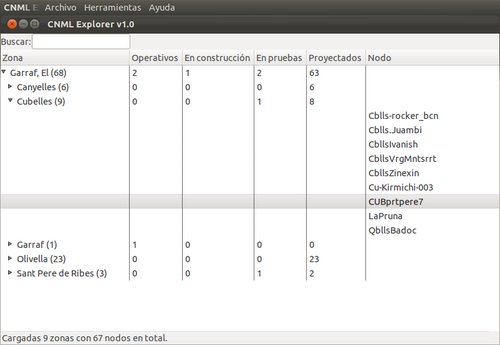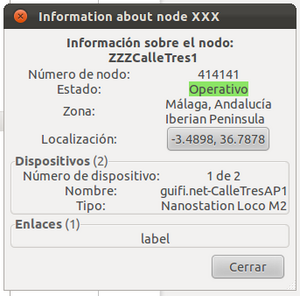Diferencia entre revisiones de «Guifi.net Studio»
De Guifi.net - Wiki Hispano
(→Project summary) |
|||
| Línea 1: | Línea 1: | ||
| − | '' | + | ''Under development...'' |
| − | + | ||
| − | + | ||
| − | + | ||
| − | + | ||
| − | + | ||
| − | + | ||
| − | + | ||
| − | + | ||
| − | + | ||
== Identity == | == Identity == | ||
| Línea 22: | Línea 13: | ||
== Project summary == | == Project summary == | ||
In order to understand better this project, you need to know first what is CNML. You can have a look to [[CNML|this article]]. | In order to understand better this project, you need to know first what is CNML. You can have a look to [[CNML|this article]]. | ||
| + | |||
| + | My proposal is developing a desktop application to manage these files. I will be useful for people that administer zones, workers that install Guifi.net nodes... etc. | ||
| + | |||
| + | CNML files offer a lot of possibilities that are not being exploited actually. It can also be used for statistics, data visualization, which will help people in their studies, or thesis about libre networks. | ||
| + | |||
| + | This application will load a CNML file and show its contents in friendly windows. Users will be able to filter nodes or zones by name, coordinates or hardware used. | ||
| + | |||
| + | It could also be a first step to develop a client that allowed users to modify their nodes by means of an API without having to use their web browsers. | ||
| + | |||
| + | It will also use some library (not decided yet) to show nodes in the world map like OpenStreetMap (OSM). In particular, OSM would allow final users to visualize nodes in the map without requiring any Internet connection as the maps are free and can be cached. | ||
| + | |||
| + | I will develop it using Python and GTK as I already control and have experience in both. It would be cool to write it in Vala, but it would take me more time learning Vala as I don't actually know too much about it. I prefer to focus on the functionalities and Python is a language that permits you to develop quickly. | ||
| + | |||
| + | The idea of this project came to me during Summer 2011 and I started it. Unfortunately I couldn't spend much time on it, so what I did is only a proof of concept. Working on it full time during the Summer 2012 would be amazing :) | ||
| + | |||
| + | You can have a look to the code in my GitHub repository<ref>[https://github.com/PabloCastellano/pablog-scripts/tree/master/guifi/cnml_explorer pablog-scripts GitHub repository]</ref>. As a picture is worth a thousand words, here there are two screenshots: | ||
[[Archivo:Cnml_explorer2.png|500px]] [[Archivo:Cnml_explorer1.png|300px]] | [[Archivo:Cnml_explorer2.png|500px]] [[Archivo:Cnml_explorer1.png|300px]] | ||
| Línea 61: | Línea 68: | ||
[[Categoría:Google Summer of Code]] | [[Categoría:Google Summer of Code]] | ||
| + | |||
| + | = References = | ||
| + | <references/> | ||
Revisión de 03:40 28 feb 2012
Under development...
Contenido
[ocultar]Identity
Name: Pablo Castellano
Email: pablo+at+anche.no
Project title: CNML Explorer
Contact/working info
Timezone: UTC+2
Typical working hours: I prefer evenings and late nights
IRC or IM networks/handle(s): pablog@FreeNode, my email address also as Jabber account
Project summary
In order to understand better this project, you need to know first what is CNML. You can have a look to this article.
My proposal is developing a desktop application to manage these files. I will be useful for people that administer zones, workers that install Guifi.net nodes... etc.
CNML files offer a lot of possibilities that are not being exploited actually. It can also be used for statistics, data visualization, which will help people in their studies, or thesis about libre networks.
This application will load a CNML file and show its contents in friendly windows. Users will be able to filter nodes or zones by name, coordinates or hardware used.
It could also be a first step to develop a client that allowed users to modify their nodes by means of an API without having to use their web browsers.
It will also use some library (not decided yet) to show nodes in the world map like OpenStreetMap (OSM). In particular, OSM would allow final users to visualize nodes in the map without requiring any Internet connection as the maps are free and can be cached.
I will develop it using Python and GTK as I already control and have experience in both. It would be cool to write it in Vala, but it would take me more time learning Vala as I don't actually know too much about it. I prefer to focus on the functionalities and Python is a language that permits you to develop quickly.
The idea of this project came to me during Summer 2011 and I started it. Unfortunately I couldn't spend much time on it, so what I did is only a proof of concept. Working on it full time during the Summer 2012 would be amazing :)
You can have a look to the code in my GitHub repository[1]. As a picture is worth a thousand words, here there are two screenshots:
About you
I'm currently studying Computers Engineering in the Autonomous University of Barcelona (UAB). I'm a geek and free software supporter who has been dealing with Linux since I was 13 (now I'm 23). I enjoy working in projects with social benefits. My favorite programming languages are Python and C.
Participating in GSoC is one of the things I wanted to do during my academic life. It's very exciting and Guifi.net is a big community which I like and needs more developers. Last year I tried to participate in the Mediawiki project but it was a very hasty decision and finally I didn't.
Deliverables
Required deliverables
If time permits
Project schedule
Community Bonding Period
Official Coding Period
Participation
- I will reach my mentor mostly by email to discuss all important things about the development. In emergency cases I would also phone him/her :D.
- People will be able to consult my code as I will set up a Git repository where I will commit.
- I will write a blog post about my progresses once a week.
- I will also idle in #guifi IRC channel to get in touch with the community.
- I will be listening for comments and suggestions.
Past open source experience
I'm a GNOME developer and member of the GNOME Foundation, which is the biggest project I have contributed. I have experience working with other open source projects. You can see my contributions to open source projects at my ohloh account.
I try to fix every annoying bug I find in software daily.
I like attending to free software events. I have attended to DebConf9 and Fosdem 2010 among others.

